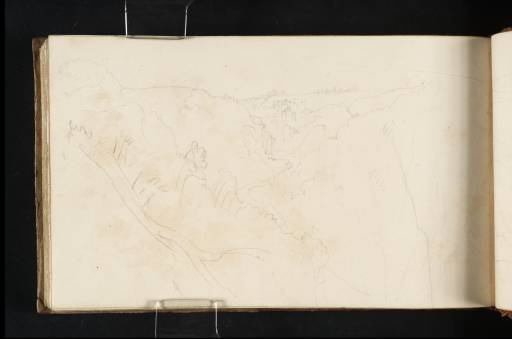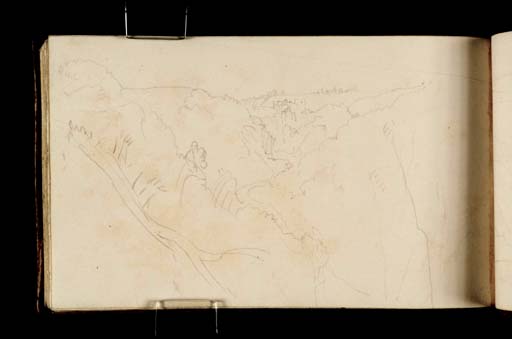Joseph Mallord William Turner Hawthornden Castle 1818
Image 1 of 2
Joseph Mallord William Turner,
Hawthornden Castle
1818
Joseph Mallord William Turner 1775–1851
Folio 81 Verso:
Hawthornden Castle 1818
D13719
Turner Bequest CLXVII 73a
Turner Bequest CLXVII 73a
Pencil on white wove paper, 112 x 186 mm
Accepted by the nation as part of the Turner Bequest 1856
References
1909
A.J. Finberg, A Complete Inventory of the Drawings of the Turner Bequest, London 1909, vol.I, p.487, CLXVII 73a, as ‘Roslin Castle.’.
Rather than Roslin Castle, as has formerly been suggested, this is more likely to be Hawthornden Castle, about a mile away to the north-east. From a point near Roslin Castle we look along ‘the narrow glen which connects these two celebrated spots’ towards Hawthornden which is perched on the steep banks of Roslin Glen.1 From this view Sir William Drummond’s seventeenth-century additions can be seen on the left with the remains of the original fifteenth-century tower to the right.
Roslin and Hawthornden are both subjects covered in the Provincial Antiquities and the two are discussed in a single text in which Walter Scott describes the picturesque ruins along the glen and ‘the romantic and classical vicinity of Hawthornden’.2 In this sketch Turner matches Scott’s picturesque evocation by including a fallen tree in the right foreground. This helps to capture the rugged nature of the landscape while emphasising the height and steepness of the vale in the foreground and the distance to the castle beyond. Although Turner may have sketched Hawthornden because he suspected that it would appear in the Provincial Antiquities, the fact that he only made one sketch from a distance and does not seem to have actually visited the castle suggests that his interest was incidental. Perhaps he was prompted by literary associations in the same way that he was inspired to paint Alexander Pope’s Villa at Twickenham (exhibited 1808, private collection),3 Scott’s homes at Abbotsford from the Northern Bank of the Tweed, circa 1836 (watercolour, private collection)4 and Sir Walter Scott’s birthplace, No. 39 Castle Street, Edinburgh, circa 1836 (watercolour, private collection).5
Hawthornden was eventually engraved by James C. Allen after John Alexander Schetky and was published in the seventh number of the Provincial Antiquities along with Turner’s view of Roslin Castle, circa 1820 (watercolour, Indianapolis Museum of Art).6
Thomas Ardill
May 2008
How to cite
Thomas Ardill, ‘Hawthornden Castle 1818 by Joseph Mallord William Turner’, catalogue entry, May 2008, in David Blayney Brown (ed.), J.M.W. Turner: Sketchbooks, Drawings and Watercolours, Tate Research Publication, December 2012, https://www


